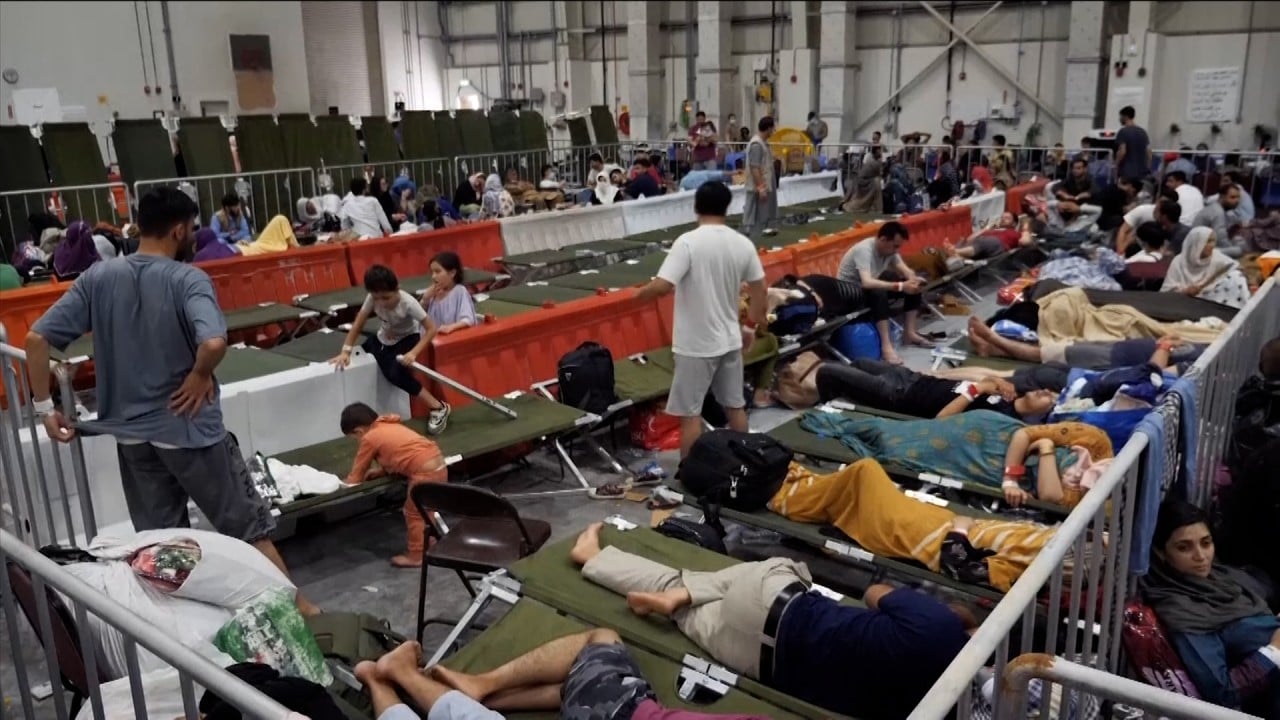
Evacuated Afghans hoping to resettle in United States face extended limbo in third countries
- Following the scramble to evacuate vulnerable Afghans, thousands of people were now waiting in ‘transit hubs’ in third countries
- The hubs included US military bases in Qatar, Germany and Italy where Afghans must overcome bureaucratic hurdles to eventually enter the US
In mid-August, Ahmad got an urgent call from his nephew, Zia, telling him to come immediately to Kabul airport to try to get on an evacuation flight.
Members of the Taliban had been to Ahmad’s house in the capital looking for Zia, who had worked with the United States military in Afghanistan. They also wanted Ahmad, who was not at home at the time, to report to the police station, Zia told him.
Ahmad, 43, worried he would be arrested or executed because of his nephew’s involvement with the US military, which flew out its last remaining troops this week in a chaotic withdrawal, formally ending a 20-year war.
Ahmad went to the airport with his wife and six children but got separated from them in the crowds at the entrance gates, he said. He showed officials a photo of his nephew’s green card on his phone and told them he was a member of his family. That was enough to get him – alone – onto a plane to the US-allied Gulf Arab state of Qatar, he said.
Following the scramble to evacuate vulnerable Afghans, thousands of people, some with no documentation or pending US visa applications, others in families with mixed immigration statuses, were now waiting in “transit hubs” in third countries. The hubs included US military bases in Qatar, Germany and Italy where Afghans must overcome bureaucratic immigration hurdles to eventually enter the United States.
“I am so disturbed about leaving them,” Ahmad said by phone, speaking through an interpreter about his wife, five daughters and two-year-old son, who are now in hiding.
Ahmad spoke on condition he be identified only by his first name to protect his family.
Army General Mark Milley, chairman of the Joint Chiefs of Staff, said on Wednesday there were about 43,000 evacuees in nine countries in Europe and the Middle East, and some 20,000 Afghans at eight military bases in the United States.
At the US military base in Qatar, people lined up for hours for food, fearful that there would not be enough to go around, said Ahmad. He had only the clothes he arrived in, which quickly became sweat-drenched in the 38-degree heat.
His nephew, Zia, was a US permanent resident so was able to fly to Seattle, Washington, with his wife and five children – three of whom had pending visa applications but no visas – after two weeks in Qatar. Ahmad and another nephew, who had only Afghan identity documents, remain.
Some evacuees without visas had been allowed into the United States temporarily on urgent humanitarian grounds, rather than under the traditional refugee programme.
‘Surging resources’
SIVs were available to certain Afghans who aided US forces as interpreters and translators, as well as in other roles, and who fear reprisals by the Taliban.
A White House official said the US government was “surging resources” to bases abroad to screen those hoping to enter the United States.
Much was still unclear to refugee groups, immigration lawyers and individual Afghans about how long some people might have to wait overseas as checks on their applications move forward.
The immigration bureaucracy was “cumbersome and there is a lot of complexity to it”, said Steve Miska, a former White House official who was helping coordinate evacuation efforts by non-profit and veterans groups.

02:37
US still has mission to process refugees after withdrawal from Afghanistan
Advocates have long criticised the slow-moving, multi-step SIV application process, which had left many petitions languishing without resolution for years. Refugee groups said the delays were unjustified because SIV applicants had extensive documentation of their work with US entities and posed no national security threat.
For Afghans such as Ahmad, who had no pending visa applications, the groups said the US government could draw on its experience vetting refugees and asylum seekers who often crossed borders without documents, to allow their passage to the United States.
Many of these Afghans had their fingerprints and photos collected over the years, either by US government officials or Afghan authorities who shared information with the United States.
“The US can figure out who people are, but this takes time and resources and whether the US government is going to bother to help people or force the people themselves to meet an impossible burden,” said Margaret Stock, a military and immigration expert.
No visibility
“That’s an entire category of refugees I am not sure our government has visibility on,” Miska said. “Those are the ones I am really nervous about”, since they might struggle to lodge petitions to enter the United States.
Around 3,500 Afghans were brought to the United Arab Emirates on charter flights by a US non-profit, according to a diplomat familiar with the situation.
These Afghans were not being processed to go to the United States, the diplomat said, as Washington was prioritising the roughly 4,000 people in the UAE evacuated on US government flights. The diplomat said it was expected to take months to process all these evacuees.
The groups that leveraged personal connections and raised private donations to charter flights out of Afghanistan may lack the expertise to help people navigate the complex US immigration system, said Miska, the former White House official.
Many Afghans now found themselves in unfamiliar countries with no clear idea of where they would be able to permanently settle.
Albania accepted a couple hundred staff members and Afghans affiliated with the Open Society Foundations, a philanthropic organisation founded by billionaire George Soros, said Laura Silber, a vice-president for the group.
She said the organisation was trying to help their staff as they considered whether to apply for visas or resettlement in the United States or elsewhere.
Albanian officials have welcomed the evacuees – many of whom only had national identity cards and no passports – and put them up in a local beach resort.
Some who made it on to evacuation flights were haunted by the idea they could have brought along more relatives.
“I feel so guilty,” said Zia’s wife, Tahera, now in Seattle. “What if I could have gotten them out?”




